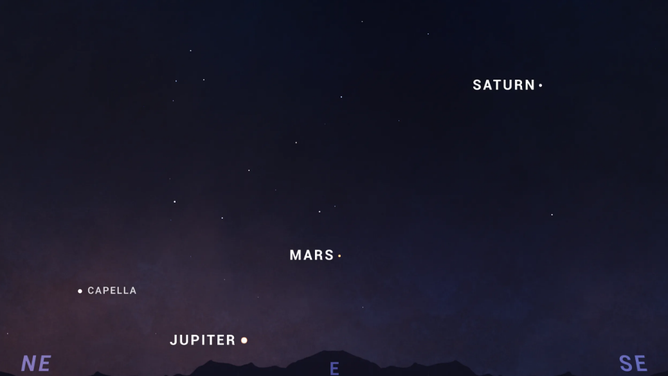Planetary parade on display in the night sky this weekend
The Moon is currently in a waning crescent phase, which occurs after a full moon. During this phase, the crescent shape of the Moon will appear to be to shrink until it reaches its new moon status on July 5.
See what's new in the journey to reach the Moon
What's next for exploration of Earth's only natural satellite.
Stargazers wishing to see a planetary parade will get their first chance this weekend when Mars, Saturn, Jupiter and the Moon will all be visible in the night sky.
According to planetary experts at NASA, the three planets, along with the crescent-shaped Moon, will be visible in the eastern sky before daybreak for the next several days.
If skies are clear, all should be visible without the use of binoculars or a telescope, but it is always advised to use aids to see the planets in all their glory.
With binoculars, some of Jupiter’s moons might be noticeable, and telescopes have previously helped with spotting Saturn’s rings from Earth.
Locales that have a clear view of the eastern horizon without the influence of light pollution have the best chance of seeing the parade.
The Moon is currently in a waning crescent phase, which occurs after a full moon. During this phase, the crescent shape of the Moon will appear to shrink until it reaches its new moon status on July 5th.

Rendering showing the planets Saturn, Mars and Jupiter.
(NASA)
WATCH OUT FOR THESE ASTRONOMICAL EVENTS IN 2024
If promises of a planetary parade sound familiar, erroneous claims went viral earlier this month, telling skygazers that six planets would be visible to the naked eye.
NASA experts said, in reality, only two planets were visible without the use of technology.
Despite promises of spectacular planetary parades, astronomers say 2024 has not disappointed with the largest display of Northern Lights in decades and the total solar eclipse that traveled across America in April.

The moon takes about 29.5 days to complete a full cycle.
(NASA)
SEE THE OBJECTS HUMANS LEFT BEHIND ON THE MOON
If you miss June’s final event, three planets are expected to be visible in mid-July.
Mercury will be apparent just after sunset on July 15 and should be fairly bright, while both Mars and Uranus will appear close in the sky.
The Full Buck Moon will peak during the morning hours on July 21, and the Southern Delta Aquarid meteor shower will occasionally be visible from mid-July through the middle of August.
